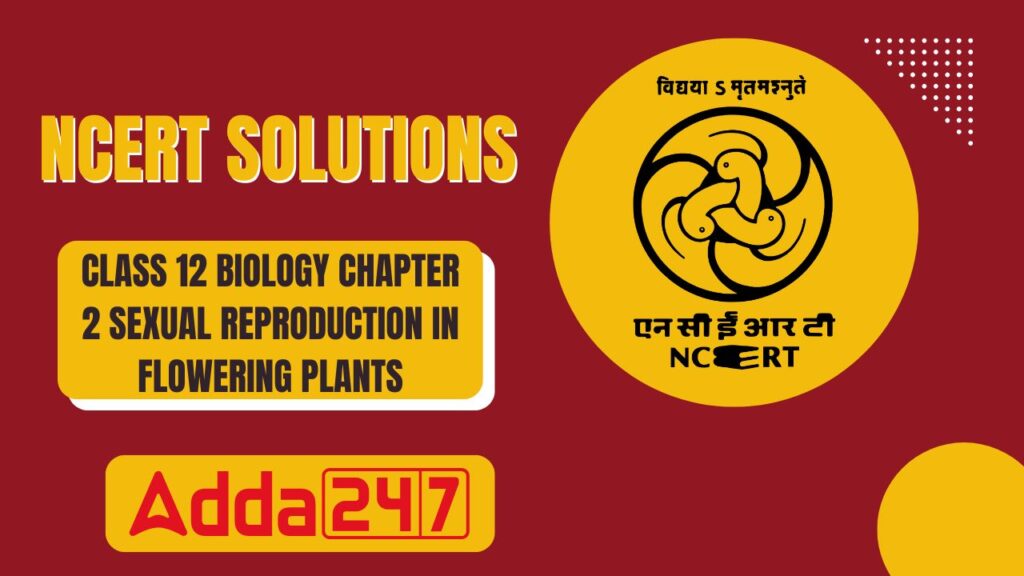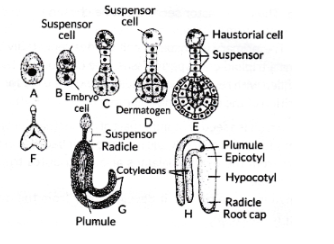
The Chapter 2 of the NCERT Class 12 Biology textbook is named as Sexual Reproduction in Flowering Plants. As the name suggests, students in this chapter are taught about the various aspects and factors of the Sexual Reproduction in Flowering Plants. Some of the most important topics covered in this chapter are Flower Structure, Pollination, Fertilization, Seed Development, Fruit Formation, Seed Dispersal, etc.
The expert faculty members at Adda247 have crafted the NCERT Solutions for Class 12 Biology Chapter 2 Sexual Reproduction in Flowering Plants as listed below in the article so that all the students can complete their exam preparation easily.
Overview of CBSE Class 12 Biology Chapter 2
The CBSE Class 12 Biology Syllabus defines that the students in their Chapter 2 need to study and learn about the various fundamentals and basics of Sexual Reproduction in Flowering Plants:
- Flower Structure: Anatomy of flowers, including reproductive parts (stamens and pistil)
- Microsporogenesis and Megasporogenesis: Formation of male and female gametophytes
- Pollination: Types (self and cross), agents (wind, water, insects), and adaptations
- Pollen-Pistil Interaction: Compatibility and rejection mechanisms
- Double Fertilization: Fusion of male gametes with the egg and polar nuclei
- Post-Fertilization Events: Formation of embryo, endosperm, seed, and fruit
- Special Mechanisms: Apomixis, polyembryony, and artificial hybridization
- Significance: Role of sexual reproduction in genetic diversity and plant breeding
NCERT Solutions for Class 12 Biology Chapter 2 Sexual Reproduction in Flowering Plants
During the preparation phase for the final examinations, students will get stuck on numerous questions. Therefore, to make their preparation phase easier, we have provided the NCERT Solutions for Class 12 Biology Chapter 2 Sexual Reproduction in Flowering Plants in the article below:
Q1. Where are the following structures present in a male gametophyte of an angiosperm? Mention the function of each one of them.
(a) Germ pore
(b) Sporopollenin
(c) Generative cell
Sol. (a) Germ pore is present on exine of pollen grains. It is the place where exine and sporopollenin is absent. The contents of the pollen grain move into the pollen tube through the germ pore.
(b) Sporopollenin is present on the outer surface of pollen grains. Sporopollenin is one of the most resistant organic materials known. It can withstand high temperatures and strong acids and alkali. No enzyme that degrades sporopollenin is so far known.
(c) Generative cell is one of the two cells present inside the pollen grain which mitotically produce two male gametes before grains are shed at 3-celled stage.
Q2. Mention the advantages of emasculation and bagging in artificial hybridisation in plants bearing unisexual and bisexual flowers.
Sol. Emasculation is removal of stamens from floral buds of female parents. A breeder needs to emasculate a flower to eliminate the chances of self- pollination. If flowers are unisexual, there is no need of emasculation. Bagging is the protection of emasculated flower from contamination by undesirable pollen grains. Here, the flowers are masked by a bag, till the stigma attains receptivity. In unisexual flowers, bagging is done before flowers are open.
Both emasculation and bagging ensure that the female flower is completely protected from
contamination. When the stigma of bagged flower attains receptivity, mature pollen grains collected from anthers of desired male parent are dusted on the stigma and flowers are rebagged till the desired result is obtained.
Q3. What is ‘bagging’? State its importance in artificial hybridisation of flowering plants.
Sol. Bagging is a plant breeding technique in which the stigma of a flower is covered with bags. ln this technique, the anthers of a bisexual flower are removed and the flower is wrapped with paper bags or butter paper till the flowers attain receptivity. Once the flower attains stigma receptivity, the desired pollens are dusted on the stigma. This is resealed to allow fruits to develop. Bagging ensures that the female flower is completely protected from
contamination. Hence, artificial hybridisation ensures that the right type of pollen has been transferred to the stigma of the flower. ln addition, the chance of fertilisation is high. Through this approach, a variety of crops can be developed and it improves the quality of crop with desirable characters.
Q4. Express the process of pollination in Vallisneria.
Sol. Pollination in Vallisneria is accomplished through water. The female flower reaches the surface of water by the long stalk and the male flowers or pollen grains are released on to the surface of water. They are carried passively by water currents and some of them eventually reach the female flowers and the stigma. pollen grains are covered by mucilage which helps them in sticking to stigma as well as protect them from wetting by water. After pollination, the female flower is pulled inside water by the coiling of its stalk.
Q5. What is cleistogamy? Write one advantage and one disadvantage of it, to the plant.
Sol. Cleistogamy is the condition where pollination occurs in closed flowers that do not open at all. In such flowers, that anthers and stigma lie close to each other. An advantage of cleistogamy is that seed setting is assured even in the absence of pollinators as pollen on maturity will always reach the stigma due to their close placement. A disadvantage of cleistogamy is that it does not allow cross pollination, thereby restricting chances of genetic variability.
Q6. List the different types of pollination depending the source of pollen grain.
Sol. Based on the source of pollen grain, pollination can be of following three types:
(i) Autogamy: Autogamy (self-pollination is the transfer of pollen grains from anther to the stigma of the same flower.
(ii) Geitonogamy: lt is the transfer of pollen grains from the anther of one flower to the stigma of another flower on the same plant. Geitonogamy is functionally cross-pollination involving a pollinating agent but genetically it is equivalent to autogamy since the pollen grains come from the same plant.
(iii) Xenogamy: It is the transfer of pollen grains from anther to the stigma of different plants of same species. It brings genetically different types of pollen grains to the stigma.
Q7. Angiosperms bearing unisexual flowers are said to be either monoecious or dioecious. Explain with the help of one example of each.
Sol. Unisexual flowers are flowers bearing either male or female reproductive structures. Male flower is staminate, i.e., bearing stamens while female flower is pistillate i.e., bearing pistils. In some flowering plants, both male and female flowers are present on same plant. Such plants are referred to as monoecious, e.g., cucurbits. In some plants, unisexual male and female flowers are present on separate plants. Such plants are referred to as dioecious, e.g., papaya.
Q8. A single pea plant in your kitchen garden produces pods with viable seeds, but the individual papaya plant does not. Explain.
Sol. Pea Plant has bisexual flowers i.e., male and female in the same flower. Therefore, it undergoes self-pollination. Thus, a single pea plant can produce viable seeds after pollination and fertilisation. However, a papaya plant is dioecious plant i.e., bearing male and female flowers on different plants and requires cross pollination for production of viable seeds. Thus, in absence of either stamens or pistils, fertilisation will not take place and hence viable seeds will not be produced.
Q9. Why do hermaphrodite angiosperms develop outbreeding devices? Explain any two such devices with the help of examples.
Sol. Hermaphrodite angiosperms develop outbreeding devices to avoid self-pollination and encourage cross pollination. Two outbreeding devices which ensure cross pollination are as follows:
(i) Dichogamy: Anthers and stigmas mature at different times in a bisexual flower. It is of two types: (a) Protandry: Anthers mature earlier than stigma of the same flower. Their pollen grains become available to stigmas of the older flowers, e.g., Sunflower, Salvia. (b) Protogyny: Stigmas mature earlier so that they get pollinated before the anthers of the same flower develop pollen grains, e.g., Mirabilis jalapa, Gloriosa, Plantago.
(ii) Self sterlity (Self incompatibility): Pollen grains of a flower do not germinate on the stigma of
the same flower due to presence of similar self- sterile gene ( 𝑆1𝑆3 in pistil and 𝑆1 or 𝑆3 in pollen grain) e.g., tobacco, potato, crucifers.
Q10. Explain three different modes of pollination that can occur in a chasmogamous flower.
Sol. A chasmogamous flower can undergo
(i) Self-pollination or autogamy: Here pollens of a flower fertilise the stigma of the same flower.
(ii) Geitonogamy: Here pollens of one flower fertilise the stigma of another. flower present on the same plant.
(iii) Xenogamy or cross pollination: Here pollens of one flower fertilise the stigma of another flower present on different plant of same species.
Q11. Differentiate between wind pollinated and insect pollinated flowers.
Sol. Differences between anemophilous (wind pollinated) and entomophilous (insect pollinated) flowers are as follows:
| Wind Pollinate flowers |
Insect pollinated flowers
|
| Flowers are small. |
Flowers are either large or if small they are grouped to form inflorescence.
|
| Flowers are inconspicucous due to the absence of bright colours. |
Flowers are usually gaudy due to the presence of
bright colours in corolla, sepals, bracts, etc. |
| They are odourless. |
Odour is commonly present.
|
| The flowers are devoid of nectar and edible pollen. |
The flowers usually possess nectar and edible pollen.
|
| Sepals and petals are either indistinguishable or absent. |
Sepals and petals are commonly well developed.
|
| Anthers are usually exserted. |
Anthers are usually inserted.
|
| Pollen grains are light and unwettable. |
Pollen grains are heavier and sticky.
|
| Pollination is non-directional. |
Pollination is specific and directional.
|
| Stigmas are exserted. |
Stigmas are commonly inserted.
|
| Stigmas are branched or hairy to catch wind borne pollen grains. E.g., maize, many grasses, etc. |
Stigmas are usually unbranched and sticky. E.g.,
Rafflesia, Mimosa. |
Q12. (a) Differentiate between geitonogamy and xenogamy.
(b) Write difference in the characteristics of the progeny produced as a result of the two processes.
Sol. a) Differences between geitonogamy and xenogamy are as follows:
| Geitonogamy | Xenogamy |
| It is pollination between two flowers of the same plant. |
It is pollination between two flowers of different plants.
|
| The flowers are genetically similar. |
The flowers are genetically different.
|
(b) Geitonogamy produces genetically identical offspring as two flowers come from the same plant while in xenogamy genetic variability among the offspring is high as two flowers come from two different plants. Therefore, the progeny obtained from the process of xenogamy give higher yield with better varieties and advanced characters than that of the progeny obtained by geitonogamy.
Q13. (i) Explain any four devices that flowering plants have developed to encourage cross-pollination.
(ii) Why do plants discourage self-pollination? State any one reason.
Sol. (i) Flowering plants have developed following devices to encourage cross-pollination which are as follows:
(1) In some plants, flowers are unisexual so that self-pollination is not possible. The plants may be monoecious (bearing both male and female flowers on same plant, e.g., maize) or dioecious (bearing male and female flowers on different plants, e.g., mulberry, papaya).
(2) Self-incompatibility (Self-sterility) is a genetic mechanism and prevents self-pollen (from the same flower or other flowers of the same plant) from fertilizing the ovules of the same flower or other flowers of same plant by inhibiting pollen germination or pollen tube growth in the pistil. It is due to the presence of similar self-sterile gene, e.g., tobacco, potato.
(3) Anthers and stigmas mature at different times in a bisexual flower, to encourage cross-pollination. It is of two types:
ss(a) Protandry: Anthers mature earlier than stigma of the same flower. Their pollen grains become available to stigmas of the older flowers, e.g., Sunflower, Salvia.
(b) Protogyny:Stigmas mature earlier so that they get pollinated before the anthers of the same flower develop pollen grains, e.g., Mirabilis jalapa, Gloriosa, Plantago.
(4) In some species, the anther and stigma are placed at different positions so that the pollen cannot come in contact with the stigma of the same flower. It prevents autogamy.
(ii) Flowering plants discourage self-pollination because continued self-pollination will result in inbreeding depression.
Q14. Explain the development of a mature embryo from the embryo sac of dicot flower.
Sol. In a typical dicot flower, after double fertilisation, the zygote elongates and then divides by a transverse wall into two unequal cells. The larger basal cell is called suspensor cell. The other towards the antipodal end is termed as terminal cell or embryo ell. The suspensor cell divides transversely a few times to produce a filamentous suspensor of 6-10 cells. The suspensor cell helps in pushing the embryo in the endosperm. The first cell of the suspensor towards the micropylar end becomes swollen and functions as a haustorium. The last cell of the suspensor is known as hypophysis. Hypophysis later gives rise to the radicle and root cap. The embryo cell undergoes two vertical divisions and one transverse division to form eight cells arranged in two tiers- epibasal (terminal) and hypobasal (near the suspensor). The epibasal cells eventually form the two cotyledons and the plumule. The hypobasal cells produce the hypocotyl except its tip. Stages in the development of a dicot embryo are represented diagrammatically as follows:















